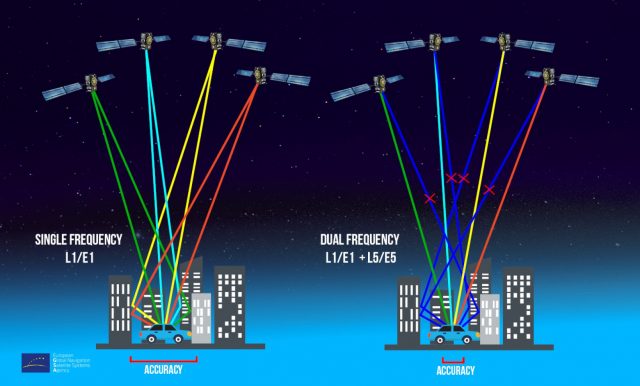Accuracy of GPS data
Your smart phone calculates coordinates and other location data from the data it receives from navigation satellites.
The navigation satellite system is called GNSS (Global Navigation Satellite System).
There are following four GNSS systems: American GPS, Russian GLONASS, Chinese BeiDou and EU Galileo.
GPS was the first and the only one system so it is the most famous one. In the meantime, however, the other 3 global navigation satellite systems have been operational.
 Source: commons.wikimedia.org
Source: commons.wikimedia.org
Most satellites send data in the so-called L1 frequency band, however the latest satellites send data in the L5 frequency band.
L5 signals are significantly more accurate than L1 signals.
The names of the frequency bands are: GPS (L1, L5), GLONASS (L1, L5), BeiDou (B1, B2a), Galileo (E1, E5a).
Older smart phone models have a chip only for receiving GPS L1 signals, while newer smart phone models have a chip for receiving signals from all GNSS systems with a dual frequency band L1 + L5.
The following mobile phone models support GNSS and dual frequency band L1 + L5: Samsung Galaxy S20, Huawei Mate 30, Huawei Mate 40, Xiaomi Mi 9T Pro, Xiaomi Mi 10 Pro, Xiaomi Mi 11 Pro, Realme X50 Pro.
The accuracy of the coordinates (latitude and longitude) depends mostly on the number of satellites your smart phone receives.
The more the number of satellites the better the accuracy. Also the more number of satellites with L5 signal the better the accuracy.
Accuracy is negatively affected by signal obstacles such as large buildings or valleys with slopes. The accuracy is also negatively affected by the poor state of the ionosphere and troposphere, usually during bad weather.
So, you will have the most accurate coordinates of your location in an open space in good weather with a high-quality smart phone that receives L1 + L5 signals from a large number of visible GNSS satellites.
 Source: European GNSS Agency
Source: European GNSS Agency
You can see a list of currently visible GNSS satellites with frequency bands using the Gps Parcela app.